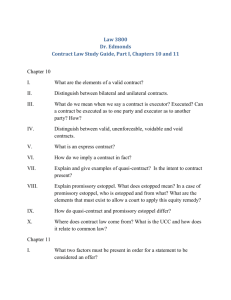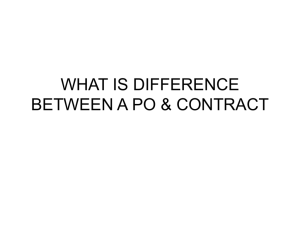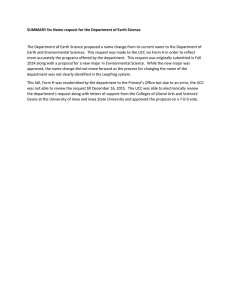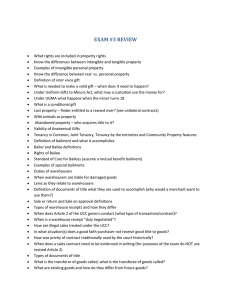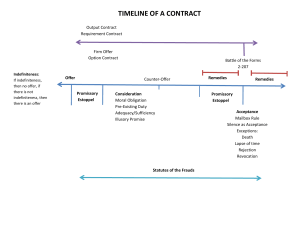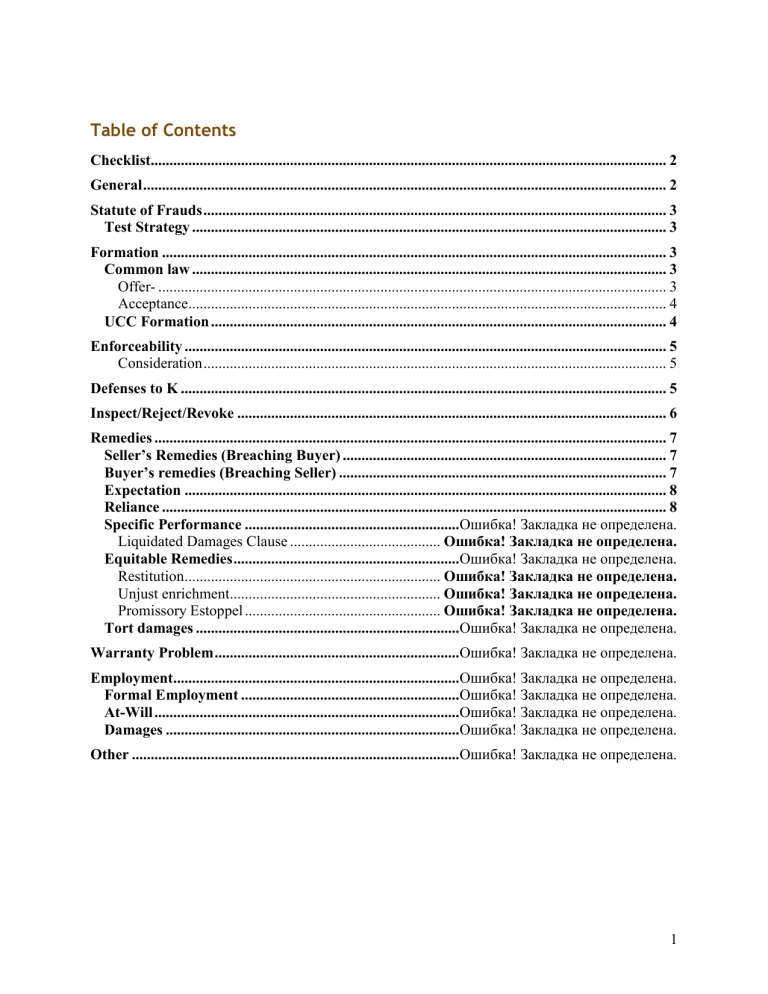
Table of Contents Checklist......................................................................................................................................... 2 General ........................................................................................................................................... 2 Statute of Frauds ........................................................................................................................... 3 Test Strategy .............................................................................................................................. 3 Formation ...................................................................................................................................... 3 Common law .............................................................................................................................. 3 Offer- ....................................................................................................................................... 3 Acceptance............................................................................................................................... 4 UCC Formation ......................................................................................................................... 4 Enforceability ................................................................................................................................ 5 Consideration ........................................................................................................................... 5 Defenses to K ................................................................................................................................. 5 Inspect/Reject/Revoke .................................................................................................................. 6 Remedies ........................................................................................................................................ 7 Seller’s Remedies (Breaching Buyer) ...................................................................................... 7 Buyer’s remedies (Breaching Seller) ....................................................................................... 7 Expectation ................................................................................................................................ 8 Reliance ...................................................................................................................................... 8 Specific Performance .........................................................Ошибка! Закладка не определена. Liquidated Damages Clause ........................................ Ошибка! Закладка не определена. Equitable Remedies ............................................................Ошибка! Закладка не определена. Restitution.................................................................... Ошибка! Закладка не определена. Unjust enrichment........................................................ Ошибка! Закладка не определена. Promissory Estoppel .................................................... Ошибка! Закладка не определена. Tort damages ......................................................................Ошибка! Закладка не определена. Warranty Problem .................................................................Ошибка! Закладка не определена. Employment............................................................................Ошибка! Закладка не определена. Formal Employment ..........................................................Ошибка! Закладка не определена. At-Will .................................................................................Ошибка! Закладка не определена. Damages ..............................................................................Ошибка! Закладка не определена. Other .......................................................................................Ошибка! Закладка не определена. 1 Checklist 1. UCC or common law? Good v. service. Bonebrake. ANALYZE 2. Is there a contract? a) Oral K? Nothing written, or nothing signed, or not enough to make a K b) SoF? i) ii) iii) iv) v) 3. 4. 5. 6. 7. Is there an oral agreement? If written, was it signed/authenticated by required party or parties? If not, is this the type of K that SoF requires to be written or signed? If yes, are there any specific exceptions (i.e. part performance)? If no, is it enforceable under the general exception? (PrE R2K § 139) c) Offer/accept/consideration? d) Exceptions? Part performance or promissory estoppel? Promissory Estoppel? Defenses to K? Was there problem with goods? a) Did B have chance to inspect? Was chance taken? Was defect noticeable? b) Were good revoked once defect noticed? What warranties were given? a) What warranties were correctly disclaimed? b) What warranties are thus left? c) Do remainder conflict? Are remedies limited? a) Is it Liquidated Damages Clause that’s not penalty? b) Does other remedy fix problem? General 1) UCC or Common law? a) UCC 2-102- transactions in goods [items movable at time of identification to the K (2105)] b) Analyze K. If predominant factor is goods (UCC) or services (Restatement). Software comes under the common law c) 2-107(1) & (2) [p. 135]: (1) A contract for the sale of minerals or the like (including oil and gas) or a structure or its materials to be removed from realty is a contract for the sale of goods within this Article if they are to be severed by the seller . . .. (2) “A contract for the sale apart from the land of growing crops or other things attached to realty and capable of severance without material harm thereto . . . or of timber to be cut is a contract for the sale of goods . . ..” d) COMMON LAW – data, intellectual property, services, property e) MIXED GOODS AND SERVICE – i) Bonebrake – is the contract for labor w/goods incidentally involved? Common Law. Is K for goods with labor incidentally involved? UCC. ii) Another test: look at the gravamen of the action/complaint. 2) “Good faith”: UCC § 1-201(a)(20) [p. 99]: “[H]onesty in fact and the observance of reasonable commercial standards of fair dealing.” 2 Statute of Frauds Test Strategy a) Does the K fall w/in the SoF? Contacts “within” the statue are only enforceable if they are in writing and signed by enforcee b) If so, is it written? Was it signed? Loosest is memo signed by party it is begin enforced against c) If not, does it fall under one of the exceptions? part performance in land, main purpose in surety d) Does promissory estoppel apply? (RESTATEMENT § 139) 1. What is “within the statute of frauds”? MOLES 500 a) M-Marriage Contacts to marry (think prenups) Probs won’t need to do much with this b) O- One Year K that cannot be done within a year i) That means specified w/in contract. Like, 366 days. Even if it is logically/physically impossible, like a ten-year-old to be paid upon their graduation from law school, it is technically possible to do that in a year. c) L- Land K for the sale of land i) Part Performance exception: If every other part of the deal is clear, such as if a son has been working the farm for twenty years, keeping it up, paying the expenses, and it is generally accepted that there is an oral contract to give the farm, the only thing lacking is a written K, then courts can enforce the oral K. Written K was mere formality (RODMAN & POWELL) p. 312 ii) Promissory estoppel- exact same as non-SoF promissory estoppel. If great injustice would result from failure to enforce RESTATEMENT § 139 d) E- Executors K for one to be an executor of an estate. This will probably never come up e) S- Surety to answer for the debts of another. Co-signing falls into this. i) Exception for “Main Purpose.” If the reason you are covering another’s debts is for your own benefit, say they are your only business partner, then oral K can be enforced. f) $500 Contracts for sale of goods over $500. ONLY IN UCC 2-201 i) Some state statutes overrule this 2. UCC 2-201 2.1. K for goods over $500 unenforceable unless signed by enforcee 2.2. Exceptions (3) [p. 137] 3. Restatement §131, 32, 139 p. 15 Formation Common law Offer- manifestation of willingness to enter into bargain §24 3 a) When both are present, there is mutual assent. The bargain is formed. §17. Meeting of the minds. §22 if both parties agree there was mutual assent, there is no need to identify the parts b) Offers are revocable until acceptance (mailbox rule) Unless means of acceptance specified, acceptance is present once it leaves hands of offeree Acceptance- manifestation of assent “(1) Acceptance of an offer is a manifestation of assent to the terms thereof made by the offeree in a manner invited or required by the offer” § 50 c) Acceptance can be in any reasonable, customarily used form § 65 d) Unless it is a “firm offer” upon which offeree relies §87 e) Counter offers count as rejections, and mirror image acceptances are counter offers. (UCC §207 is different) f) Silence is only acceptance if it has been agreed to be. (continued relationships) g) § 33(3) “The fact that one or more terms of a proposed bargain are left open or uncertain may show that a manifestation of intention is not intended to be understood as an offer or as an acceptance.” h) Ads are not normally offers, but invitations to negotiate. Unless award offer, with very specific terms and reward set aside. i) LEONARD V PEPSICO ii) Exceptions (1) Where the advertisement is ‘clear, definite, and explicit, and leaves nothing open for negotiation . . . it constitutes an offer, acceptance of which will complete the K” (LEFKOWITZ) (2) Reward offers - Advertisements offering rewards are offers to anybody who performs the conditions named in the advertisement, and anybody who does perform the condition accepts the offer” [CARBOLIC SMOKE BALL] (3) i) Medical cases are contracts if there is proof it differs from normal procedure, such as if a Dr. gave incentive to a party in order to operate. Consider Dr. offering, and patient accepting. i) If there is a K, then recovery can be expectation, the difference between the goal of the hand and the current hand (see H AWKINS) or reliance, which covers medical expenses and pain and suffering. (SULLIVAN). Either compensate to put patient back where they thought they would be, or where they were. Not both. UCC Formation j) 2-204 i) K may be made in any way that shows agreement, including conduct showing both parties agree there is a K. ii) ProCD – consumer K is formed at purchase; later terms have to be explicitly agreed to iii) Exact moment of formation need not be found 4 k) l) m) n) iv) If there is a gap, K still exists, if parties intended to make K and remedy has a solid basis. v) will fill gaps as to price (2-305); place of delivery (2-308); time of delivery (2-309); and time of payment (2-310) 2-205- Firm offer 2-206: “an offer to make a K shall be construed as inviting acceptance in any manner and by any medium reasonable in the circumstances.” 511(2) -Tender in payment of any normal form can be acceptance, unless S has specified 207 - “definite and seasonal expression of acceptance” means there is a K, mirror images accepted as acceptance Enforceability 1) 2) 3) 4) 5) 6) Consideration-exchange of value Can be forbearance of legal right, or exchange of values, does not need to benefit either party. As long as something has changed hands that would not have w/o K, there is consideration. (See H AMER V . SIDWAY guy who didn’t drink) Promise sought/given in exchange for performance. Must be close connection. A nexus. Reciprocal inducement Why? a) So people take it seriously b) So we only have to deal with serious contracts c) Evidence of K. d) To organize world in K deals and no K deals. Like torts. KIRKSEY no contract, no consideration. Was gratuity, a gift. RICKETTS was also not a K. Was a gift. No consideration from promisee. But promissory estoppel is applicable, quit job in reliance upon K. Injustice would occur absent enforcement. a) Not k? There was no bargain. No mutual assent. ReS §71- promise for a promise (or act/forbearance/ modification of legal right) neither promise needs to come from or go to parties to K. Defenses to K 1) Illegal K a) K for illegal items or actions are normally unenforceable. i) Exceptions: (1) Not active participant: Carol (2) Not at equal fault in pari delicte : Coma & Karpinski (3) Equity and public policy – courts do what they want 2) EULA/ More duty to read. a) Pro-CD- public good to enforce EULA. Allows for important info to be on outside, and rest of term inside, with right to read and revoke. Like insurance, adhesion K. Allows for low costs. Parties are free to contract, and both sides benefited by EULA. Already 5 accepted LA, but has right to revoke it after reading it. K formed by clicking “I agree” But if you click, you do agree, whether read or not. b) Hill v Gateway- Ruling above applies to hardware as well. Knew term inside box. Ought to have read them. 3) Unconscionability RS § 208 UCC 2-302 a) Williams v Walker Thomas Rent to own scheme unfair to poor people. Look at terms of K in light of circumstances of parties. Does B know enough to work with S un equal footing? b) B&B 1500% interest. No. c) Procedural Uncon. i) Substantial evidence party lacked knowledge/experience [did not know what they signed] ii) S took advantage of B’s weakness [opportunistic use of above] iii) Took advantage to grossly unfair degree iv) Or gross disparity between value and price d) Substantial uncon i) K terms unreasonable ii) Purpose /effect of terms iii) One sidedness of terms iv) General public policy Inspect/Reject/Revoke 1. 2-513: “(1) Unless otherwise agreed and subject to subsection (3), where goods are tendered or delivered or identified to the contract for sale, the buyer has a right before payment or acceptance to inspect them at any reasonable place and time and in any reasonable manner.” 2. 2:601- perfect tender, with right of rejection for any reason- accept/reject/do both to parts 2.1. 508- S has right to fix thing and continue w/ K. 2.2. 2-508(2): “(2) Where the buyer rejects a non-conforming tender which the seller had reasonable grounds to believe would be acceptable . . . the seller may if he seasonably notifies the buyer have a further reasonable time to substitute a conforming tender.” 3. 602: “(1) Rejection of goods must be within a reasonable time after their delivery or tender. It is ineffective unless the buyer seasonably notifies the seller.” 4. 603- B merchants 604-B Salvage 5. 606- acceptance precludes 607- rejection 6. 608- revoke acceptance if substantial impairment (See COLONIAL DODGE ) 7. 1) Deposits- 718 (2)- when seller justifiably withholds delivery of goods because of buyer’s breach… buyer is entitled to restitution… sum of his payment exceeds” LDC, or 20% of value of total performance or $500, whichever is smaller. 2) ReS § 356 3) Duty to mitigate/ cover (SEE PARKER) a) Exception: LVS under 2-708(2) (NERI V. RETAIL MARINE) As long as not “different or inferior” Apply the JORDAN test: i) If they had the capacity to sell more ii) If they had the subjective intent to do so 6 Remedies UCC § 1-305 [p. 129]: “The remedies provided by the [UCC] shall be liberally administered to the end that the aggrieved party may be put in as good a position as if the other party had fully performed but neither consequential or special damages nor penal damages may be had except as specifically provided by the [UCC] or by other rule of law.” Seller’s Remedies (Breaching Buyer) a) 2-703 Menu (p.261) i) resell and recover damages as in 2-706 - Must be in good faith (1-201) and commercially reasonable. difference between (resell price and KP) + incidentalssavings (1) Private sale w/ notification of buyer 2-706 (3) (2) Public sale (auction/usual place for public sale) 2-706 (4) (3) S does not owe B anything ii) Recover damages for nonacceptance 2-708 (1) Market price less KP+ incidentals less savings (708 (1)) (2) If this does not put S at expectation, Damage is profit. (For LVS + Scrap) (708(2) (3) Full KP for accepted goods, but B keeps those goods. (709) [essentially SP of K.] iii) Recover the price in the proper case, if goods cannot reasonably be resold 2-709 (PARKER) iv) Incidental Damages 2-710- Charges made after breach for care/custody/resale v) If Lost Volume Seller, can recover profit (NERI) 2-708(2) b) Exception: LVS under (NERI V. RETAIL MARINE) Apply the JORDAN test: i) If they had the capacity to sell more ii) If they had the subjective intent to do so Buyer’s remedies (Breaching Seller) 2-711 c) Menu 2-708 (p. 273) Cancel, and recover so much of the price as has been paid (restitution) i) Cover 712 Cover price less KP + incidental and consequential (if S had notice as in HADLEY ) ii) Recovery 713 MP when buyer learned of breach less KP + ID + CD – savings iii) Incidental and consequential 715- reasonably incurred post-breach & losses the seller had reason to know of and are reasonable, and could not be prevented by covering, (see HADLEY, damages ought to be naturally occurring/foreseeable or disclosed at the formation of K) The cost must have been within the contemplation of both parties at time of K (1) Exception, sort of: CHUNG whether a plaintiff can prove lost profits with reasonable certainty d) recover the goods i) Specific performance 716- Unique or other proper circumstances (Copylease) If there is no way to cover, or B has tried and failed, right to replevin. e) (3) resell goods already in possession after revocation or rejection. 2) Common Law ReS § 344 (p.45) 7 Buyer Breaches Seller Breaches Falling Market 2-708 deters breach by making BB pay K-market difference “Non-normal”: no expectation recovery for NBB but maybe there is reliance/restitution Rising Market “Non-normal”: no damage recovery for NBS but maybe there is reliance/restitution Normal: S wants to breach to sell above K price in market. 2-713 makes BS pay K-Mkt difference to NBB Expectation Put the NB in the position they’d have been in if breacher had perfomed. UCC 1305 § 347- (a) loss in value … (b) … incidental/ consequential … (c) [less] cost… avoided HAWKINS V . MCGEE (Hairy Hand) measure of damages is the difference between the value [of the thing purchased] if it had corresponded with the warranty and its actual value, together with such incidental losses. Damages for only more suffering than was bargained for/anticipated can be recovered under either reliance or expectation. (SULLIVAN – nose) Reliance §349- expenditures made in preparation for performance…less any loss… the injured party would have suffered see SECURITY STOVE “If Δ had notice of the unusual loss, it can be assumed they K for it.” Whole damage would not have been sustained except for the reliance by the π on the Δ a) Limit: “reasonable” reliance b) “Hand Limitation” from L ALBERT (RUBBER): If “performance would not have covered the promisee’s outlay, . . . the promisee may recover his outlay in preparation for the performance, subject to the privilege of the promisor [BS] to reduce it by as much as he can show that the promisee [NBB] would have lost, if the contract had been performed.” c) R2K 349: [Reliance expenditures] “less any loss that the party in breach can prove with reasonable certainty the injured party would have suffered had the contract been performed.” 8
